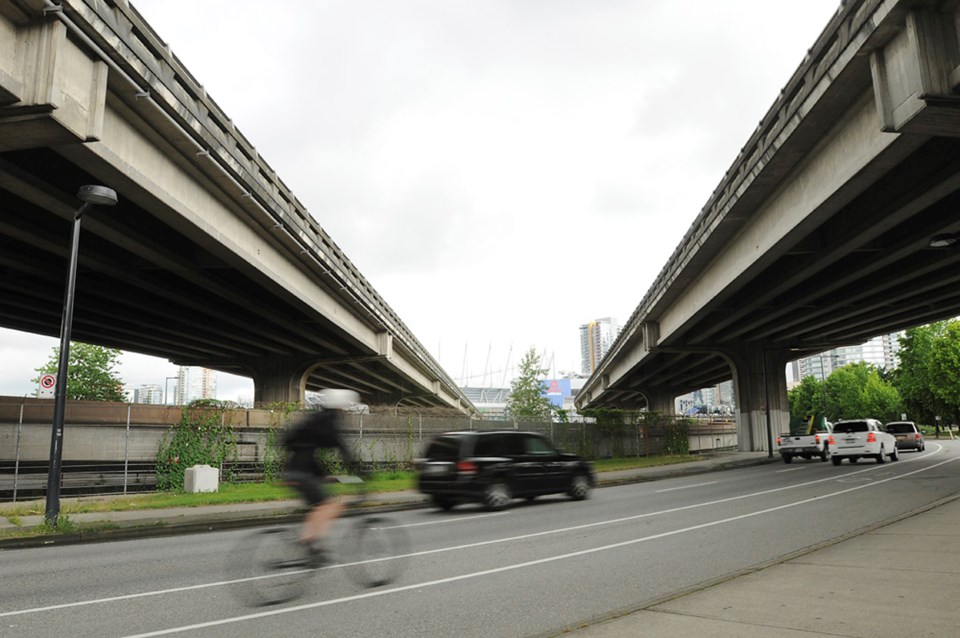The crammed-to-the-rafters Vancouver Playhouse auditorium should have been evidence enough of our obsession with how cities are built. It was an exultant tweet, however, by urban affairs reporter Frances Bula that summed up the occasion.
“An amazing packed house of young people at the Janette Sadik-Khan talk tonight. Watch out, status quo!”
A who’s who of influential urban thinkers lined the front rows before the evening’s keynote by New York City’s former transportation commissioner. They included architect Bing Thom, urban planners Brent Toderian, Frank Ducote and Sandy James, and assorted elected officials from around the region, including the mayors of New Westminster and Abbotsford, and Vancouver city councillor Heather Deal.
The plucky Sadik-Khan is on a promotional tour for her book Streetfight, which she and co-author Seth Solomonow tout as a handbook for reinvigorating how cities are designed. She presented with a New Yorker’s warmth and a wry smile that suggests she loves being the warrior for safer and more livable streets.
She is still the object of scorn from some who opposed NYC’s adoption of street space for bike lanes and public plazas. But recent public polls show 73 per cent of New Yorkers favour the changes Sadik-Khan and her commission colleagues brought.
What is happening in New York is also taking place in other cities, including Vancouver. Our own intense debates over the future of our transportation network and the best use of the public domain were brought into focus at Sadik-Khan’s talk.
The evening provided a number of exciting moments.
The first was seeing Gordon Price, director of the SFU city program, a former four-term NPA city councillor and a leading voice for cities. Price has had a recent health challenge that took him away from the public spotlight.
Grinning ear-to-ear thanks to the sold-out crowd, Price ably moderated the Q&A session and served as an enthusiastic emcee.
The second was the public announcement by Lon LaClaire that he has been hired as the City of Vancouver’s new director of transportation. The appointment of LaClaire — the first senior staff hiring since Sadhu Johnston became city manager — was an inspired choice.
LaClaire is an almost boyish-looking 50 years old. He has worked at the City of Vancouver for approximately 20 years, and has remained a loyal city employee despite numerous offers to work elsewhere.
LaClaire, it is said, loves our city. He takes the job during a time when some of the most formidable changes are happening in its transportation network.
Consider what is coming to Vancouver: the re-imagining of the Arbutus Corridor, newly purchased by the city, the removal of the Georgia and Dunsmuir Viaducts and the new plan for northeast False Creek, the Broadway subway and the continuation of the Millennium Line Skytrain, establishing a bike share program, and major renovations to the Burrard Bridge just to start.
The city is also weighing the future of Robson Square as a public plaza. In addition, engineers are taking a hard look at Gastown’s future (will it become pedestrian-only?) while it figures out how to restore its weary cobblestone streets.
Then there are the bike lanes, which bring out critics in droves.
Controversy has already erupted on the proposed bike lane on Commercial Drive, between East 14th and First Avenue. The local BIA, regrettably in my view, released the results of a survey slanted to garner a negative reaction.
A more dispassionate look at the Commercial Drive bike lane should have people jumping up and down with glee. By bringing millions of dollars of street improvements, that part of the Drive stands to win big by drawing more pedestrians, cyclists and shoppers.
But because we have given short shrift to public opinion in the past, these new developments have been unnecessarily divisive.
Streetfight co-author Solomonow served as press secretary to the transportation commissioner, and it was his top-flight communications and media relations skills — including extensive public consultation — that ensured Sadik-Khan’s plan could succeed.
When it comes to Vancouver’s transportation and its public realm, the status quo is simply not an option.
For LaClaire and his colleagues to succeed, the city has to get serious about how it communicates with citizens. They also need a city council that will back them 100 per cent.
@MikeKlassen



